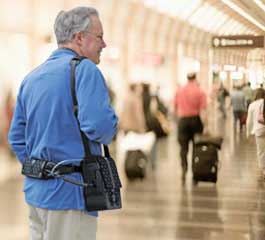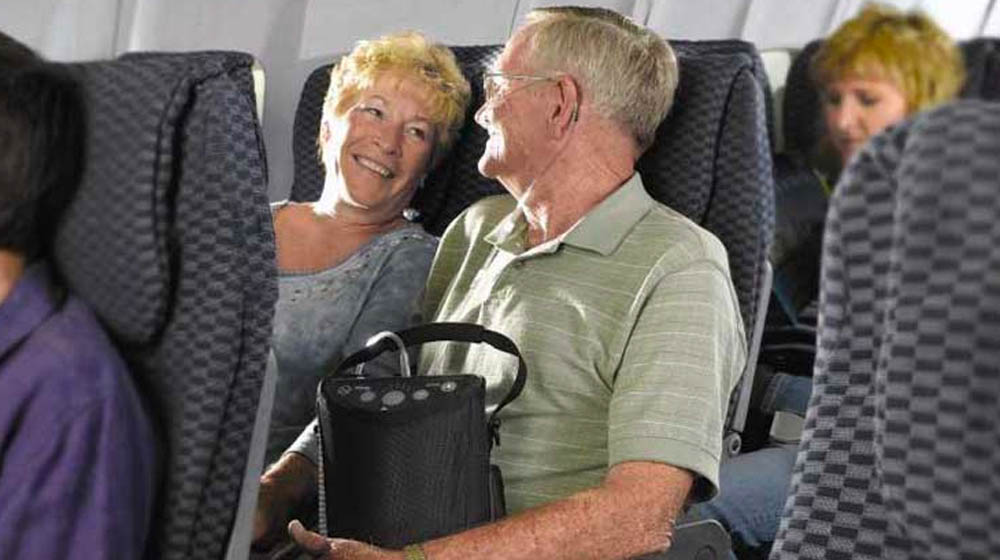If you plan on traveling with your portable oxygen concentrator, there are some things you’ll need to know before your trip to make it as seamless as possible. People travel with portable oxygen concentrators every day, and this guide shows you how.
Flying with your portable oxygen concentrator
The Federal Aviation Administration doesn’t allow passengers to bring portable oxygen tanks or liquid oxygen on flights. This leaves a portable oxygen concentrator as your only option when it comes to traveling by air. This law applies to all United States aircraft with more than 19 seats. All flights traveling to and from the United States must allow portable oxygen concentrators as well. This rule eliminates operational requirements and allows passengers to use a portable oxygen concentrator that works for their needs.
Before you show up to the airport to catch your flight, there are several things you need to do. It’s important to talk to your doctor before your trip to discuss your oxygen needs. You’ll want to get a note from your doctor expressing your medical needs and oxygen prescription in writing and what equipment you require. You should keep this note with you as you travel in case you run into any problems. The FAA doesn’t explicitly require a doctor’s note, but some airlines do, so make sure you reach out to your airline before your trip to determine if you’ll need a letter.
The FAA has a list of portable oxygen concentrators that are compliant with their guidelines, but it’s still important to check in with your airline to find out additional details about traveling with your portable oxygen concentrator.

Although aircraft have outlets to charge devices, don’t rely on them for charging your portable oxygen concentrator. Make sure you bring enough batteries. The FAA and airlines require you to bring batteries to last 150 percent of your expected flight duration. So, if you have a 10-hour flight, you’ll be required to bring batteries that can power your concentrator for at least 15 hours. This should include any layover time you have.
Rechargeable batteries have rules, though. They must be protected by either keeping them in their original packaging, insulating the terminals by taping over them or by placing each battery in an individual plastic bag. It’s important to note you can’t carry your spare batteries in checked bags on a flight.
While flying, there are some things to consider to make both yourself and other passengers safe and comfortable:
-
It’s important that you store your concentrator in a place that keeps the aisle free so passengers can walk and move about easily without fear of tripping over your device. The best place to store your concentrator is under your seat.
-
The FAA requires that when flying, the tubing for the portable oxygen concentrator must be at least seven feet in length, which is long enough for the concentrator to be used while still stored under your seat.
-
A pressurized airplane cabin can affect your oxygen flow rate. It’s likely you’ll need to increase your flow rate during the flight to maintain the oxygen saturation you’re used to. This can make your batteries die quicker.
Traveling on a cruise ship with your portable oxygen concentrator
Cruise lines make it very easy to travel with oxygen. Make sure you work with a travel agent or agent from your tour company who can help you communicate your oxygen needs with the cruise line and ensure everything is taken care of for you. The agent can help you arrange for oxygen pick-up at various ports, too.
Companies like Sea Puffer offer group sailing trips for oxygen-users and help arrange details of your travel for you. Notify the cruise line that you’ll be bringing along your concentrator at least a month in advance of your departure date. Find out if your doctor needs to fill out any forms for you.
When you can, make sure you plug your portable oxygen concentrator into an electrical outlet to save the life of your batteries. If your concentrator has a short battery life, contact dining areas ahead of time to see if you can reserve a table that has an outlet near it.
If you plan on going on any excursions during your cruise, it’s a good idea to talk to an activities coordinator ahead of time to determine physical requirements during the outing. Explain your use of a portable oxygen concentrator to make sure it’s feasible for you to go.
| Dos and Don’ts of Traveling with a Portable Oxygen Concentrator |
|
|---|---|
| DO | DON’T |
| Do carry your tank in the supplied case | Don’t place your POC in a car trunk or other tightly enclosed space |
| Do keep your POC out of direct sunlight or other heat sources | Don’t get your POC wet |
| Do bring extra batteries | Don’t store liquid oxygen or oxygen tanks on their side or unsecured |
| Do make arrangements with airlines and destinations beforehand | |
| Do be aware of high altitudes. Flying or driving in high altitude can increase your need for oxygen | |
Traveling by car or bus with your portable oxygen concentrator
Driving a car or RV can be the most convenient option for those who use a portable oxygen concentrator. If you plan to drive, you’ll want to talk to your doctor about how much of an oxygen supply you’ll need. That way you can determine if you’ll need to stop anywhere to refill your supply. If you have to stop, your doctor can help you arrange a location for pick-up from another source.
It’s a good idea to find the information for a local hospital beforehand, so you have their details in case something goes wrong with your portable oxygen concentrator. Additionally, researching some oxygen suppliers beforehand will come in handy if there’s an emergency.
If you decide to take a bus, make sure you check with the company to find out any rules or regulations about your concentrator beforehand. Portable containers are allowed on all buses and trains but policies and procedures may vary. Try to book a seat that has access to power outlets so you can charge your concentrator on the trip. This will be useful since you won’t have to rely on batteries during the drive. Still, make sure you have plenty of spare batteries in case of an emergency.


